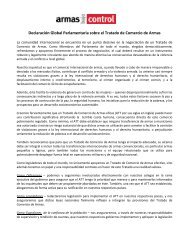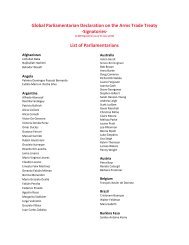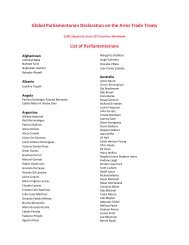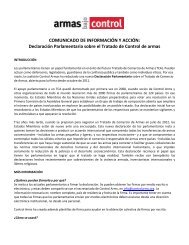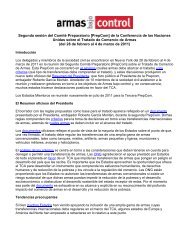SAFERWORLD 11mechanism to facil<strong>it</strong>ate information exchange among, and ensure access for, all statesparties. This could then involve states parties subm<strong>it</strong>ting requests for information toan appropriate Treaty body – possibly an ATT Secretariat (see section 4.1 below) –which could have access to information from relevant international instruments(e.g. the International Tracing Instrument) and/or which could engage w<strong>it</strong>happropriate national and regional contact points.3.2.3 Exchanginginformation ondiversion risksThe risk of diversion of arms during or post international transfer is widely recognisedas a key facet of the illic<strong>it</strong> arms trade. It is increasingly evident that the diversion ofarms is one important way in which terrorist groups and other unauthorised nonstateactors can acquire arms; at the same time diverted arms can also fuel destabilisingaccumulations and contribute to breaches of human rights and internationalhuman<strong>it</strong>arian law. Since preventing the diversion of arms should be a key objective ofan ATT the arch<strong>it</strong>ects of the regime should seriously consider including the exchangeof relevant information amongst states parties. Such exchanges on diversion riskscould be undertaken in the same way as the proposed exchanges on actors of concern(above), i.e. states parties would be encouraged to provide relevant information to anappropriate Treaty body (e.g. an ATT Secretariat) which could then take steps toinvestigate further and inform other states parties.ConclusionUnder an ATT, a variety of information exchanges between states parties could beenabled:■The exchange of information on denials of international arms transfer licences couldconst<strong>it</strong>ute an important mechanism for maintaining levels of international armstransfer restraint. Even if <strong>it</strong> is not possible to immediately establish a mandatory denialnotification requirement under an ATT, consideration should be given to theestablishment of provisions for voluntary exchanges or for the future development ofa denial notification mechanism.■ Exchanges of information among states on actors of concern w<strong>it</strong>hin the internationalarms transfer chain would allow a greater number of states to make informedinternational arms transfer licensing decisions.■ Preventing diversion of arms will be a key aspect of an ATT. Provision should beestablished under an ATT for the exchange of information between states parties ondiversion risks.3.3TransparencyprovisionsWhile comprehensive provisions relating to reporting and information exchange willbe crucial to the effective functioning of an ATT, unless there is a degree of transparencysurrounding these activ<strong>it</strong>ies there will be l<strong>it</strong>tle to encourage public supportfor the regime. Although states have sought to portray the confidential reporting andinformation exchanges that take place w<strong>it</strong>hin multilateral fora, such as the WassenaarArrangement, as const<strong>it</strong>uting a form of transparency, such exchanges do not adequatelyserve the requirements of transparency in the wider sense. This report defines transparencyas placing information (e.g. concerning the implementation, verification andmon<strong>it</strong>oring of an ATT) in the public domain.Concern among international public opinion in relation to the unregulated andirresponsible trade in arms has undoubtedly been a key factor in raising the issue ofan ATT to the top of the governmental agenda. Accordingly, the inclusion of public
12 MAKING IT WORK: MONITORING AND VERIFYING IMPLEMENTATION OF AN ARMS TRADE TREATYtransparency provisions will be important in order to foster public confidence in theimplementation of the Treaty. However, not all states have been comfortable w<strong>it</strong>h thenotion of public transparency surrounding the arms trade. The most frequentlyrepeated arguments against the public disclosure of information concern ‘nationalsecur<strong>it</strong>y’ and ‘commercial confidential<strong>it</strong>y’ issues. It is important to realise, however,that matters of national secur<strong>it</strong>y often arise in relation to the potential policies and/oractions of other states. However, if states parties have already shared w<strong>it</strong>h all otherstates parties comprehensive reports on their national implementation of an ATT(including details of international arms transfers), then they can have few argumentsagainst releasing such information to national parliaments and the public. Whereconcerns relate to commercial issues regarding compet<strong>it</strong>ors, fears should be assuagedby the fact that all reporting would be retrospective.The level of public transparency regarding current international arms transfer controlregimes varies significantly. While some have aspired to a certain level of opennessthrough the publication of operating procedures and guidelines relating to variousexport control-related issues, few have provided significant levels of public transparencyin relation to international arms transfers. Indeed, the extent to which informationon international arms transfers is made public appears largely dependent on acombination of two factors: firstly the purpose of the regime in the eyes of the statesparties; and secondly the level of trust and pol<strong>it</strong>ical coherence among the participatingstates. For example the declared aims of the EU Code of Conduct on <strong>Arms</strong> Exportsincluded the wish to “strengthen the exchange of relevant information w<strong>it</strong>h a view toachieving greater transparency”. However, there was in<strong>it</strong>ially no promise of publicreporting on arms exports by Member States. Over time, however, as EU MemberStates have grown accustomed to the operation of the Code, levels of public reportingon international arms transfers have increased. EU states now publicly report on allarms export licences (and most report on actual exports/deliveries), listed by Mil<strong>it</strong>aryList category, although, as mentioned earlier, this is still insufficient to allow a fullyaccurate assessment of how the EU Code is being implemented in practice.The Wassenaar Arrangement, on the other hand, was established to “promote transparencyand greater responsibil<strong>it</strong>y in international transfers of conventional arms anddual-use goods and technologies, thus preventing destabilising accumulations”. 18However, since <strong>it</strong>s inception <strong>it</strong> has become clear that any increase in transparency thatis referred to in the In<strong>it</strong>ial Elements is intended for state-to-state informationexchanges only and is not intended for public consumption. While information on thetypes of exchanges that take place w<strong>it</strong>hin Wassenaar and a plethora of guidelines onissues ranging from export controls to disposal of surplus mil<strong>it</strong>ary equipment havebeen published, information on international transfers of weapons has not. This hasmeant that <strong>it</strong> is not possible for those outside the governments of the states parties tojudge objectively whether or not the regime is making pos<strong>it</strong>ive progress towardsmeeting <strong>it</strong>s stated objectives.Although <strong>it</strong> might be considered that the levels of pol<strong>it</strong>ical coherence among the statesreporting publicly to the UN Register on Conventional <strong>Arms</strong> Transfers would berelatively low, the raison d’etre of the UN Register is nevertheless to discourage thedestabilising accumulation of conventional arms by increasing transparency in internationaltransfers. Established in 1992, the UN Register saw 95 states subm<strong>it</strong> reports in<strong>it</strong>s first year (1993). Submissions in intervening years have reached a high of 126 (2002)and a low of 85 (1999). According to the 2006 Report of the Group of GovernmentalExperts on the continuing operation and further development of the UN Register,“as at 28 July 2006, a total of 170 States have participated in the Register at least once byreporting on international arms transfers and/or by providing add<strong>it</strong>ional backgroundinformation. During the 13 years of operation of the Register, 142 States have18 Wassenaar Arrangement In<strong>it</strong>ial Elements http://www.wassenaar.org/



